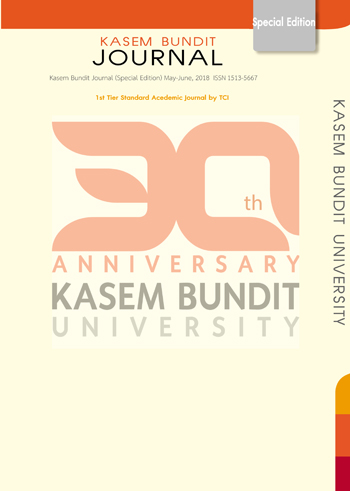Laboratory-Based Learning to Study the Pullout Test of an Anchor in Concrete
Keywords:
Laboratory-Based Learning, Pullout Test of Anchor, Engineering EducationAbstract
Abstract
This paper presents the evaluation of laboratory-based learning in civil engineering study on the topic of a single pullout test of an anchll-outr embedded into concrete according to ASTM E488/488M standard. In this study, the authors developed the laboratory handout and designed a series of learning approaches for the students to make them to understand the consequences. A total of 55 students, currently studying at King Mongkut’s University of Technology Thonburi, in Civil Technology Education program, was joined in this study. Evaluation tool used in this research was descriptive questions to evaluate the competency in this topic in three different stages, before learning (pre-test), after giving a full lecture in the classroom (post-test 1), and after giving a full lecture and laboratory-based learning (post-test 2). All the questions were proved by index of item objective congruence (IOC) from the three experts in this field of study. To discuss and compare the results, all the queries were analysed as follows: the average (), standard deviation (SD), and t-test value. The results showed that students’ learning achievement increased scores for the pre-test (29.25%), post-test 1 (60.10%), and post-test 2 (88.30%). The results indicated that students’ knowledge was significantly improved after laboratory-based learning. Their knowledge and skill were developed, including theory and practice through this learning method, so that it should be proposed for teaching and learning in civil engineering.
References
[2] Grayson, L.P. (1993). The Making of an Engineer. New York, Jonh Wiley and Sons.
[3] Stephan, K. (2002). All This and Engineering Too. A History of Accreditation Requirements. IEEE Technology and Society Magazine.
[4] Dieog, V., Manuel, P.R., and Miguel, L. (2016). “New Approach for the Teaching of Concrete Compression Tests in Large Group of Engineering Students”. Journal of Professional Issue in Engineering Education and Practice. pp. 1-9.
[5] Abdulwahed, M., and Nagy, Z.K. (2009). “Applying Kolbs’ Experiential Learning Cycle for Laboratory Education”. Journal of Engineering Education. 98(3), pp. 283-293.
[6] Mackechnie, J.R., and Buchanan, A.H. (2012). “Creative Laboratory Model for Large Undergraduate Engineering Classes”. Journal of Professional Issue in Engineering Education and Practice. 138(1), pp. 55-61.
[7] Wurdinger, S.A., and Carlson, J.A. (2010). “Teaching for Experiential Learning, Five Approaches that Work, Rowan and Little Field Education”. Lanham, MD.
[8] Boxall, J., and Tait, S. (2008). “Inquiry-Based Learning in Civil Engineering Laboratory Classes” Proceedings of Institution of Civil Engineers. Civil Engineering. 161(3), pp. 138-143.
[9] Warehem, D.G., and Milke, M.W. (2002). “Water Quality Laboratory for Large Civil Engineering Classes”. Journal of Professional Issue in Engineering Education and Practice. 128(2), pp. 88-93.
[10] Quinn, K.A., and Albano, L.D. (2008). “Problem-Based Learning in Structural Engineering Education”. Journal of Professional Issue in Engineering Education and Practice. 134(4), pp. 329-334.
[11] Stephen, T.M. (2006). “Self-Managed Learning Model for Civil Engineering Continuing Training”. Journal of Professional Issue in Engineering Education and Practice. 132(3), pp. 209-216.
[12] Shahrizan, B., Roszilah, H., and Noraini, H. (2012). “Development of A Problem Based Learning in Concrete Technology Laboratory Work”. Procdia-Social and Behavioral Sciences. The National University of Malaysia, 60, pp. 8-13.
[13] Solis, M., Romero, A., and Galvin, P. (2012). “Teaching Structural Analysis through Design, Building, and Testing”. Journal of Professional Issue in Engineering Education and Practice. 138(3), pp. 246-252.
[14] ASTM committee E488/488M (2015). Standard Test Methods for Strength of Anchor in Concrete Elements. ASTM International, West Conshohoken, United State.
[15] ACI 318 (2011). Appendix D. Anchoring to Concrete. American Concrete Institute. pp. 417-449.
[16] Krista, L.D., Nancy, S.Y., Laura, M., Yaena, M., and Punam, H.P. (2015). “An Active-Learning Laboratory on Respiratory Devices”. Journal of Currents in Pharmacy Teaching and Learning. (7). pp. 434-442.
Downloads
Published
How to Cite
Issue
Section
License
ทัศนคติ ความคิดเห็นใด ๆ ที่ปรากฏในวารสารเกษมบัณฑิตฉบับนี้เป็นของผู้เขียน โดยเฉพาะ มหาวิทยาลัยเกษมบัณฑิตและบรรณาธิการ ไม่จำเป็นต้องมีความเห็นพ้องด้วย







